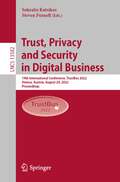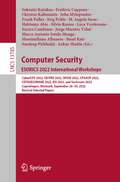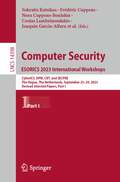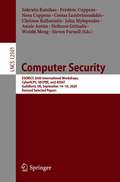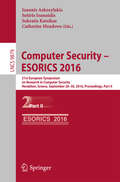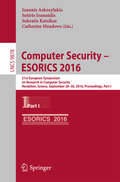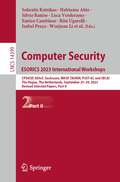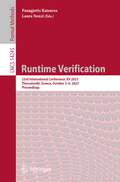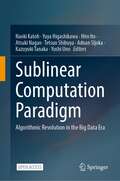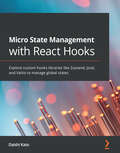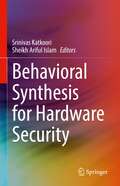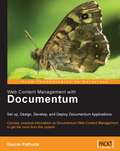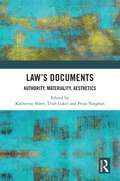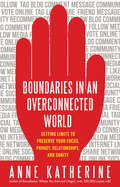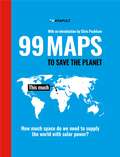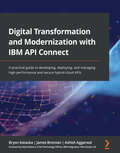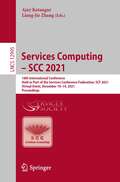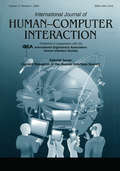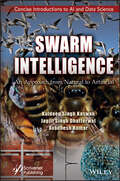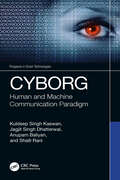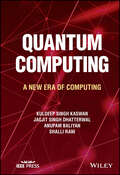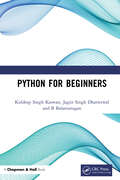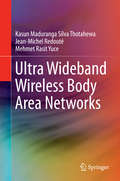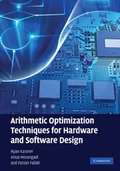- Table View
- List View
Trust, Privacy and Security in Digital Business: 19th International Conference, TrustBus 2022, Vienna, Austria, August 24, 2022, Proceedings (Lecture Notes in Computer Science #13582)
by Sokratis Katsikas Steven FurnellThis volume LNCS 13582 constitutes the papers of the 19th International Conference on Trust, Privacy and Security in Digital Business, TrustBus 2022, held in August 2022 in Vienna, Austria, as part of the DEXA 2022 conference. The 11 full papers presented were carefully reviewed and selected from 30 submissions regarding advancements in the state of the art and practice of trust and privacy in digital business. The papers are organized in topical sections: Trust; Privacy; Security; Digital business; GDPR; Authenticity-enhancing technologies; Internet of Things; Intrusion detection; Honeypots; Homomorphic encryption;, and Serious games.
Computer Security. ESORICS 2022 International Workshops: CyberICPS 2022, SECPRE 2022, SPOSE 2022, CPS4CIP 2022, CDT&SECOMANE 2022, EIS 2022, and SecAssure 2022, Copenhagen, Denmark, September 26–30, 2022, Revised Selected Papers (Lecture Notes in Computer Science #13785)
by Sokratis Katsikas Frédéric Cuppens Christos Kalloniatis John Mylopoulos Frank Pallas Jörg Pohle M. Angela Sasse Habtamu Abie Silvio Ranise Luca Verderame Enrico Cambiaso Jorge Maestre Vidal Marco Antonio Sotelo Monge Massimiliano Albanese Basel Katt Sandeep Pirbhulal Ankur ShuklaThis book constitutes the refereed proceedings of seven International Workshops which were held in conjunction with the 27th European Symposium on Research in Computer Security, ESORICS 2022, held in hybrid mode, in Copenhagen, Denmark, during September 26-30, 2022. The 39 papers included in these proceedings stem from the following workshops: 8th Workshop on the Security of Industrial Control Systems and of Cyber-Physical Systems, CyberICPS 2022, which accepted 8 papers from 15 submissions; 6th International Workshop on Security and Privacy Requirements Engineering, SECPRE 2022, which accepted 2 papers from 5 submissions; Second Workshop on Security, Privacy, Organizations, and Systems Engineering, SPOSE 2022, which accepted 4 full papers out of 13 submissions; Third Cyber-Physical Security for Critical Infrastructures Protection, CPS4CIP 2022, which accepted 9 full and 1 short paper out of 19 submissions; Second International Workshop on Cyber Defence Technologies and Secure Communications at the Network Edge, CDT & SECOMANE 2022, which accepted 5 papers out of 8 submissions; First International Workshop on Election Infrastructure Security, EIS 2022, which accepted 5 papers out of 10 submissions; and First International Workshop on System Security Assurance, SecAssure 2022, which accepted 5 papers out of 10 submissions.
Computer Security. ESORICS 2023 International Workshops: CyberICS, DPM, CBT, and SECPRE, The Hague, The Netherlands, September 25–29, 2023, Revised Selected Papers, Part I (Lecture Notes in Computer Science #14398)
by Sokratis Katsikas Frédéric Cuppens Nora Cuppens-Boulahia Costas Lambrinoudakis Joaquin Garcia-Alfaro Guillermo Navarro-Arribas Pantaleone Nespoli Christos Kalloniatis John Mylopoulos Annie Antón Stefanos GritzalisThis two-volume set LNCS 14398 and LNCS 14399 constitutes the refereed proceedings of eleven International Workshops which were held in conjunction with the 28th European Symposium on Research in Computer Security, ESORICS 2023, in The Hague, The Netherlands, during September 25-29, 2023. The 22 regular papers included in these proceedings stem from the following workshops:9th International Workshop on the Security of Industrial Control Systems and of Cyber-Physical Systems, CyberICPS 2023, which accepted 8 papers from 18 submissions;18th International Workshop on Data Privacy Management, DPM 2023, which accepted 11 papers from 18 submissions;7th International Workshop on Cryptocurrencies and Blockchain Technology, CBT 2023, which accepted 6 papers from 20 submissions;7th International Workshop on Security and Privacy Requirements Engineering, SECPRE 2023, which accepted 4 papers from 7 submissions.4th International Workshop onCyber-Physical Security for Critical Infrastructures Protection, CSPS4CIP 2023, which accepted 11 papers from 15 submissions.6th International Workshop on Attacks and Defenses for Internet-of-Things, ADIoT 2023, which accepted 6 papers from 10 submissions;Second International Workshop on System Security Assurance, SecAssure 2023, which accepted 5 papers from 8 submissions;First International Workshop on Attacks and Software Protection, WASP 2023, which accepted 7 papers from 13 submissionsInternational Workshop on Transparency, Accountability and User Control for a Responsible Internet, TAURIN 2023, which accepted 3 papers from 4 submissions;International Workshop on Private, Secure, and Trustworthy AI, PriST-AI 2023, which accepted 4 papers from 8 submissions;International Workshop on Security and Artificial Intelligence, SECAI 2023, which accepted 5 papers from 10 submissions.
Computer Security: ESORICS 2020 International Workshops, CyberICPS, SECPRE, and ADIoT, Guildford, UK, September 14–18, 2020, Revised Selected Papers (Lecture Notes in Computer Science #12501)
by Sokratis Katsikas Frédéric Cuppens Nora Cuppens Costas Lambrinoudakis Christos Kalloniatis John Mylopoulos Annie Antón Stefanos Gritzalis Weizhi Meng Steven FurnellThis book constitutes the refereed post-conference proceedings of the 6th International Workshop on Security of Industrial Control Systems and Cyber-Physical Systems, CyberICPS 2020, the Second International Workshop on Security and Privacy Requirements Engineering, SECPRE 2020, and the Third International Workshop on Attacks and Defenses for Internet-of-Things, ADIoT 2020, held in Guildford, UK, in September 2020 in conjunction with the 25th European Symposium on Research in Computer Security, ESORICS 2020. Due to COVID-19 pandemic the conference was held virtually The CyberICPS Workshop received 21 submissions from which 5 full papers were selected for presentation. They cover topics related to threats, vulnerabilities and risks that cyber-physical systems and industrial control systems face; cyberattacks that may be launched against such systems; and ways of detecting and responding to such attacks. From the SECPRE Workshop 4 full papers out of 7 submissions are included. The selected papers deal with aspects of security and privacy requirements assurance and evaluation; and security requirements elicitation and modelling and to GDPR compliance. From the ADIoT Workshop 2 full papers and 2 short papers out of 12 submissions are included. The papers focus on IoT attacks and defenses and discuss either practical or theoretical solutions to identify IoT vulnerabilities and IoT security mechanisms.
Computer Security – ESORICS 2016: 21st European Symposium on Research in Computer Security, Heraklion, Greece, September 26-30, 2016, Proceedings, Part II (Lecture Notes in Computer Science #9879)
by Sokratis Katsikas Ioannis Askoxylakis Sotiris Ioannidis Catherine MeadowsThe two-volume set, LNCS 9878 and 9879 constitutes the refereed proceedings of the 21st European Symposium on Research in Computer Security, ESORICS 2016, held in Heraklion, Greece, in September 2016. The 60 revised full papers presented were carefully reviewed and selected from 285 submissions. The papers cover a wide range of topics in security and privacy, including data protection: systems security, network security, access control, authentication, and security in such emerging areas as cloud computing, cyber-physical systems, and the Internet of Things.
Computer Security – ESORICS 2016: 21st European Symposium on Research in Computer Security, Heraklion, Greece, September 26-30, 2016, Proceedings, Part I (Lecture Notes in Computer Science #9878)
by Sokratis Katsikas Ioannis Askoxylakis Sotiris Ioannidis Catherine MeadowsThe two-volume set, LNCS 9878 and 9879 constitutes the refereed proceedings of the 21st European Symposium on Research in Computer Security, ESORICS 2016, held in Heraklion, Greece, in September 2016. The 60 revised full papers presented were carefully reviewed and selected from 285 submissions. The papers cover a wide range of topics in security and privacy, including data protection: systems security, network security, access control, authentication, and security in such emerging areas as cloud computing, cyber-physical systems, and the Internet of Things.
Computer Security. ESORICS 2023 International Workshops: CPS4CIP, ADIoT, SecAssure, WASP, TAURIN, PriST-AI, and SECAI, The Hague, The Netherlands, September 25–29, 2023, Revised Selected Papers, Part II (Lecture Notes in Computer Science #14399)
by Sokratis Katsikas Habtamu Abie Silvio Ranise Luca Verderame Enrico Cambiaso Rita Ugarelli Isabel Praça Wenjuan Li Weizhi Meng Steven Furnell Basel Katt Sandeep Pirbhulal Ankur Shukla Michele Ianni Mila Dalla Preda Kim-Kwang Raymond Choo Miguel Pupo Correia Abhishta Abhishta Giovanni Sileno Mina Alishahi Harsha Kalutarage Naoto YanaiThis two-volume set LNCS 14398 and LNCS 14399 constitutes the refereed proceedings of eleven International Workshops which were held in conjunction with the 28th European Symposium on Research in Computer Security, ESORICS 2023, in The Hague, The Netherlands, during September 25-29, 2023. The 22 regular papers included in these proceedings stem from the following workshops:9th International Workshop on the Security of Industrial Control Systems and of Cyber-Physical Systems, CyberICPS 2023, which accepted 8 papers from 18 submissions;18th International Workshop on Data Privacy Management, DPM 2023, which accepted 11 papers from 18 submissions;7th International Workshop on Cryptocurrencies and Blockchain Technology, CBT 2023, which accepted 6 papers from 20 submissions;7th International Workshop on Security and Privacy Requirements Engineering, SECPRE 2023, which accepted 4 papers from 7 submissions.4th International Workshop onCyber-Physical Security for Critical Infrastructures Protection, CSPS4CIP 2023, which accepted 11 papers from 15 submissions.6th International Workshop on Attacks and Defenses for Internet-of-Things, ADIoT 2023, which accepted 6 papers from 10 submissions;Second International Workshop on System Security Assurance, SecAssure 2023, which accepted 5 papers from 8 submissions;First International Workshop on Attacks and Software Protection, WASP 2023, which accepted 7 papers from 13 submissionsInternational Workshop on Transparency, Accountability and User Control for a Responsible Internet, TAURIN 2023, which accepted 3 papers from 4 submissions;International Workshop on Private, Secure, and Trustworthy AI, PriST-AI 2023, which accepted 4 papers from 8 submissions;International Workshop on Security and Artificial Intelligence, SECAI 2023, which accepted 5 papers from 10 submissions.
Runtime Verification: 23rd International Conference, RV 2023, Thessaloniki, Greece, October 3–6, 2023, Proceedings (Lecture Notes in Computer Science #14245)
by Panagiotis Katsaros Laura NenziThis book constitutes the refereed proceedings of the 23rd International Conference on Runtime Verification, RV 2023, held in Thessaloniki, Greece, during October 3–6, 2023. The 13 full papers and 7 short papers presented in this book together with 4 tutorial papers and 2 invited papers were carefully reviewed and selected from 39 submissions. The RV conference is concerned with all aspects of novel lightweight formal methods to monitor, analyze, and guide the runtime behavior of software and hardware systems. Runtime verification techniques are crucial for system correctness, reliability, and robustness; they provide an additional level of rigor and effectiveness compared to conventional testing and are generally more practical than exhaustive formal verification.
Sublinear Computation Paradigm: Algorithmic Revolution in the Big Data Era
by Naoki Katoh Yuya Higashikawa Hiro Ito Atsuki Nagao Tetsuo Shibuya Adnan Sljoka Kazuyuki Tanaka Yushi UnoThis open access book gives an overview of cutting-edge work on a new paradigm called the “sublinear computation paradigm,” which was proposed in the large multiyear academic research project “Foundations of Innovative Algorithms for Big Data.” That project ran from October 2014 to March 2020, in Japan. To handle the unprecedented explosion of big data sets in research, industry, and other areas of society, there is an urgent need to develop novel methods and approaches for big data analysis. To meet this need, innovative changes in algorithm theory for big data are being pursued. For example, polynomial-time algorithms have thus far been regarded as “fast,” but if a quadratic-time algorithm is applied to a petabyte-scale or larger big data set, problems are encountered in terms of computational resources or running time. To deal with this critical computational and algorithmic bottleneck, linear, sublinear, and constant time algorithms are required.The sublinear computation paradigm is proposed here in order to support innovation in the big data era. A foundation of innovative algorithms has been created by developing computational procedures, data structures, and modelling techniques for big data. The project is organized into three teams that focus on sublinear algorithms, sublinear data structures, and sublinear modelling. The work has provided high-level academic research results of strong computational and algorithmic interest, which are presented in this book.The book consists of five parts: Part I, which consists of a single chapter on the concept of the sublinear computation paradigm; Parts II, III, and IV review results on sublinear algorithms, sublinear data structures, and sublinear modelling, respectively; Part V presents application results. The information presented here will inspire the researchers who work in the field of modern algorithms.
Micro State Management with React Hooks: Explore custom hooks libraries like Zustand, Jotai, and Valtio to manage global states
by Daishi KatoExplore global state management and select the best library for your applicationKey FeaturesUnderstand the essential concepts and features of micro state managementDiscover solutions to common problems faced while implementing micro state managementExplore the different libraries, their coding style, and the optimum approach to rendering optimizationBook DescriptionState management is one of the most complex concepts in React. Traditionally, developers have used monolithic state management solutions. Thanks to React Hooks, micro state management is something tuned for moving your application from a monolith to a microservice.This book provides a hands-on approach to the implementation of micro state management that will have you up and running and productive in no time. You'll learn basic patterns for state management in React and understand how to overcome the challenges encountered when you need to make the state global. Later chapters will show you how slicing a state into pieces is the way to overcome limitations. Using hooks, you'll see how you can easily reuse logic and have several solutions for specific domains, such as form state and server cache state. Finally, you'll explore how to use libraries such as Zustand, Jotai, and Valtio to organize state and manage development efficiently.By the end of this React book, you'll have learned how to choose the right global state management solution for your app requirement.What you will learnUnderstand micro state management and how you can deal with global stateBuild libraries using micro state management along with React HooksDiscover how micro approaches are easy using React HooksUnderstand the difference between component state and module stateExplore several approaches for implementing a global stateBecome well-versed with concrete examples and libraries such as Zustand, Jotai, and ValtioWho this book is forIf you're a React developer dealing with complex global state management solutions and want to learn how to choose the best alternative based on your requirements, this book is for you. Basic knowledge of JavaScript programming, React Hooks and TypeScript is assumed.
Behavioral Synthesis for Hardware Security
by Srinivas Katkoori Sheikh Ariful IslamThis book presents state-of-the-art research results from leading electronic design automation (EDA) researchers on automated approaches for generating cyber-secure, smart hardware. The authors first provide brief background on high-level synthesis principles and motivate the need for secure design during behavioral synthesis. Then they provide readers with synthesis techniques for six automated security solutions, namely, hardware obfuscation, hardware Trojan detection, IP watermarking, state encoding, side channel attack resistance, and information flow tracking.Provides a single-source reference to behavioral synthesis for hardware security;Describes automatic synthesis techniques for algorithmic obfuscation, using code transformations;Includes behavioral synthesis techniques for intellectual property protection.
Web Content Management with Documentum
by Gaurav KathuriaConcise information about the various Documentum web content management products, and packed with practical examples. This book is targeted at IT professionals who are Documentum beginners or intermediates. The depth of coverage means that experienced Documentum developers will also benefit from the book, and learn some new tricks. Although no knowledge of Documentum is presumed, exposure to Java/J2EE, XML, and related web technologies will help to get the most from this book.
Law's Documents: Authority, Materiality, Aesthetics
by Katherine Biber, Trish Luker and Priya VaughanIlluminating their breadth and diversity, this book presents a comprehensive and multidisciplinary view of legal documents and their manifold forms, uses, materialities and meanings. In 1951, Suzanne Briet, a librarian at the Bibliotheque Nationale in Paris, famously said that an antelope in a zoo could be a document, thereby radically changing the way documents were analysed and understood. In the fifty years since this pronouncement, the digital age has introduced a potentially limitless range of digital and technological forms for the capture and storage of information. In their multiplicity and their ubiquity, documents pervade our everyday life. However, the material, intellectual, aesthetic and political dimensions and effects of documents remain difficult to pin down. Taking a multidisciplinary and international approach, this collection tackles the question, what is a legal document?, in order to explore the material, aesthetic and intellectual attributes of legal documentation; the political and colonial orders reflected and embedded in documents; and the legal, archival and social systems which order and utilise information. As well as scholars in law, documentary theory, history, Indigenous studies, art history and design theory and practice, this book will also appeal to those working in libraries, archives, galleries and museums, for whom the ongoing challenges of documentation in the digital age are urgent and timely questions.
Boundaries in an Overconnected World
by Anne KatherineOver the past decade, 24/7 connectivity has given us not only convenience and fun but worries about privacy, interruptions while working or trying to enjoy family or other downtime, and new compulsions -- from shopping to tweeting and cute-cat watching. Anne Katherine, one of the authors who brought boundary setting to a mass audience, has now written a book on how to set healthy boundaries with technology. The first of its kind, this resource doesn't suggest anyone go "cold turkey." Instead, it helps people make social media, smart phones, and other innovations work for, rather than against, them. Readers learn to protect themselves online in every way -- from predators and data mining as well as time-devouring friends and acquaintances -- with an emphasis on preserving and optimizing meaningful personal connections. Anyone who has ever wondered if their cute little gadget was actually an enemy invader will welcome Katherine's strategies for ensuring "that your life is truly your own."
Lighting for Animation: The Art of Visual Storytelling
by Jasmine Katatikarn Michael TanzilloLighting for Animation is designed with one goal in mind - to make you a better artist. Over the course of the book, Jasmine Katatikarn and Michael Tanzillo (Senior Lighting TDs, Blue Sky Studios) will train your eye to analyze your work more critically, and teach you approaches and techniques to improve your craft. Focusing on the main philosophies and core concepts utilized by industry professionals, this book builds the foundation for a successful career as a lighting artist in visual effects and computer animation. Inside you’ll find in-depth instruction on: • Creating mood and storytelling through lighting • Using light to create visual shaping • Directing the viewer’s eye with light and color • Gathering and utilizing reference images • Successfully lighting and rendering workflows • Render layers and how they can be used most effectively • Specific lighting scenarios, including character lighting, environment lighting, and lighting an animated sequence • Material properties and their work with lighting • Compositing techniques essential for a lighter • A guide on how to start your career and achieve success as a lighting artist This book is not designed to teach software packages—there are websites, instructional manuals, online demos, and traditional courses available to teach you how to operate specific computer programs. That type of training will teach you how to create an image; this book will teach you the technical skills you need to make that image beautiful. Key Features Stunning examples from a variety of films serve to inspire and inform your creative choices. Unique approach focuses on using lighting as a storytelling tool, rather than just telling you which buttons to press. Comprehensive companion website contains lighting exercises, assets, challenges, and further resources to help you expand your skillset.
99 Maps to Save the Planet: With an introduction by Chris Packham
by KATAPULT'Terrifying yet funny, surprising yet predictable, simple yet poignant' Chris PackhamA shocking but informative, eye-catching and witty book of maps that illustrate the perilous state of our planet.The maps in this book are often shocking, sometimes amusing, and packed with essential information:· Did you know that just 67 companies worldwide are responsible for 67 per cent of global greenhouse emissions? · Or that keeping a horse has the same carbon footprint as a 23,500-kilometre road trip? · Did you know how many countries use less energy than is consumed globally by downloading porn from the internet?· Do you know how much of the earth's surface has been concreted over?· Or how many trees would we have to plant to make our planet carbon-neutral?Presenting a wealth of innovative scientific research and data in stunning, beautiful infographics, 99 Maps to Save the Planet provides us with instant snapshots of the destruction of our environment. At one glance, we can see the precarious state of our planet - but also realise how easy it would be to improve it Enlightening, a bit frightening, but definitely inspiring, 99 Maps to Save the Planet doesn't provide practical tips on how to save our planet: it just presents the facts. And the facts speak for themselves. Once we know them, what excuse do we have for failing to act?
Digital Transformation and Modernization with IBM API Connect: A practical guide to developing, deploying, and managing high-performance and secure hybrid-cloud APIs
by Bryon Kataoka James Brennan Ashish Aggarwal Matt RobertsSuccessfully execute a strategic roadmap of digital transformation and modernize your enterprise with a proven API-led agile implementation approach by unlocking the full range of features in IBM API Connect Version 10Key FeaturesExplore techniques to design and deliver valuable customer-centric APIs using API ConnectManage your APIs with improved security and optimal performance across many channelsUncover hidden capabilities that help improve business agility and management within your API ecosystemBook DescriptionIBM API Connect enables organizations to drive digital innovation using its scalable and robust API management capabilities across multi-cloud and hybrid environments. With API Connect's security, flexibility, and high performance, you'll be able to meet the needs of your enterprise and clients by extending your API footprint. This book provides a complete roadmap to create, manage, govern, and publish your APIs. You'll start by learning about API Connect components, such as API managers, developer portals, gateways, and analytics subsystems, as well as the management capabilities provided by CLI commands. You'll then develop APIs using OpenAPI and discover how you can enhance them with logic policies. The book shows you how to modernize SOAP and FHIR REST services as secure APIs with authentication, OAuth2/OpenID, and JWT, and demonstrates how API Connect provides safeguards for GraphQL APIs as well as published APIs that are easy to discover and well documented. As you advance, the book guides you in generating unit tests that supplement DevOps pipelines using Git and Jenkins for improved agility, and concludes with best practices for implementing API governance and customizing API Connect components. By the end of this book, you'll have learned how to transform your business by speeding up the time-to-market of your products and increase the ROI for your enterprise.What you will learnUse API Connect to create, manage, and publish customer-centric, API-led solutionsRun CLI commands to manage API configuration and deploymentsCreate REST, SOAP, and GraphQL APIs securely using OpenAPISupport OAuth and JWT security methods using policiesCreate custom policies to supplement securityApply built-in policies to transform payloadsUse CLIs and unit testing hooks within DevOps pipelinesFind out how to customize Analytics dashboards and Portal User InterfaceWho this book is forThis book is for developers and architects who want to achieve digital transformation using IBM API Connect and successfully execute the strategic roadmap of enterprise modernization while effectively managing their API ecosystem. A solid understanding of what RESTful services and APIs can do and where to implement API security is necessary to get started. Experience in application development and basic knowledge of microservices, container orchestration, and cloud environments will help you to get the most out of this book.
Services Computing – SCC 2021: 18th International Conference, Held as Part of the Services Conference Federation, SCF 2021, Virtual Event, December 10–14, 2021, Proceedings (Lecture Notes in Computer Science #12995)
by Ajay Katangur Liang-Jie ZhangThis volume constitutes the proceedings of the 18th International Conference on Services Computing 2021, held as Part of SCF 2021 in December 2021 as a virtual event due to COVID-19. The 5 full papers and 2 short papers presented in this volume were carefully reviewed and selected from 21 submissions. It covers the science and technology of leveraging computing and information technology to model, create, operate, and manage business services.
Current Research of the Human Interface Society: A Special Issue of the international Journal of Human-computer Interaction
by Osamu KataiThis special issue is the first opportunity to introduce the research activities of the Human Interface Society. The first article gives a microworld approach to identify design requirements for better situation awareness. Next, a focus on evaluation of organizational structure in emergency situations from the communication viewpoints is examined,
Swarm Intelligence: An Approach from Natural to Artificial (Concise Introductions to AI and Data Science)
by Kuldeep Singh Kaswan Jagjit Singh Dhatterwal Avadhesh KumarSWARM INTELLIGENCE This important authored book presents valuable new insights by exploring the boundaries shared by cognitive science, social psychology, artificial life, artificial intelligence, and evolutionary computation by applying these insights to solving complex engineering problems. Motivated by the capability of the biologically inspired algorithms, “Swarm Intelligence: An Approach from Natural to Artificial” focuses on ant, cat, crow, elephant, grasshopper, water wave and whale optimization, swarm cyborg and particle swarm optimization, and presents recent developments and applications concerning optimization with swarm intelligence techniques. The goal of the book is to offer a wide spectrum of sample works developed in leading research throughout the world about innovative methodologies of swarm intelligence and foundations of engineering swarm intelligent systems; as well as applications and interesting experiences using particle swarm optimization, which is at the heart of computational intelligence. Discussed in the book are applications of various swarm intelligence models to operational planning of energy plants, modeling, and control of robots, organic computing, techniques of cloud services, bioinspired optimization, routing protocols for next-generation networks inspired by collective behaviors of insect societies and cybernetic organisms. Audience The book is directed to researchers, practicing engineers, and students in computational intelligence who are interested in enhancing their knowledge of techniques and swarm intelligence.
CYBORG: Human and Machine Communication Paradigm (Prospects in Smart Technologies)
by Kuldeep Singh Kaswan Jagjit Singh Dhatterwal Anupam Baliyan Shalli RaniThis book provides in-depth information about the technical, legal, and policy issues that are raised when humans and artificially intelligent machines are enhanced by technology. Cyborg: Human and Machine Communication Paradigm helps readers to understand cyborgs, bionic humans, and machines with increasing levels of intelligence by linking a chain of fascinating subjects together, such as the technology of cognitive, motor, and sensory prosthetics; biological and technological enhancements to humans; body hacking; and brain-computer interfaces. It also covers the existing role of the cyborg in real-world applications and offers a thorough introduction to cybernetic organisms, an exciting emerging field at the interface of the computer, engineering, mathematical, and physical sciences. Academicians, researchers, advanced-level students, and engineers that are interested in the advancements in artificial intelligence, brain-computer interfaces, and applications of human-computer in the real world will find this book very interesting.
Quantum Computing: A New Era of Computing
by Kuldeep Singh Kaswan Jagjit Singh Dhatterwal Anupam Baliyan Shalli RaniQUANTUM COMPUTING A helpful introduction to all aspects of quantum computing Quantum computing is a field combining quantum mechanics—the physical science of nature at the scale of atoms and subatomic particles—and information science. Where ordinary computing uses bits, logical values whose position can either be 0 or 1, quantum computing is built around qubits, a fundamental unit of quantum information which can exist in a superposition of both states. As quantum computers are able to complete certain kinds of functions more accurately and efficiently than computers built on classical binary logic, quantum computing is an emerging frontier which promises to revolutionize information science and its applications. This book provides a concise, accessible introduction to quantum computing. It begins by introducing the essentials of quantum mechanics that information and computer scientists require, before moving to detailed discussions of quantum computing in theory and practice. As quantum computing becomes an ever-greater part of the global information technology landscape, the knowledge in Quantum Computing will position readers to join a vital and highly marketable field of research and development. The book’s readers will also find: Detailed diagrams and illustrations throughout A broadly applicable quantum algorithm that improves on the best-known classical algorithms for a wide range of problems In-depth discussion of essential topics including key distribution, cluster state quantum computing, superconducting qubits, and more Quantum Computing is perfect for advanced undergraduate and graduate students in computer science, engineering, mathematics, or the physical sciences, as well as for researchers and academics at the intersection of these fields who want a concise reference.
Python for Beginners
by Kuldeep Singh Kaswan Jagjit Singh Dhatterwal B BalamuruganPython is an amazing programming language. It can be applied to almost any programming task. It allows for rapid development and debugging. Getting started with Python is like learning any new skill: it’s important to find a resource you connect with to guide your learning. Luckily, there’s no shortage of excellent books that can help you learn both the basic concepts of programming and the specifics of programming in Python. With the abundance of resources, it can be difficult to identify which book would be best for your situation. Python for Beginners is a concise single point of reference for all material on python. • Provides concise, need-to-know information on Python types and statements, special method names, built-in functions and exceptions, commonly used standard library modules, and other prominent Python tools • Offers practical advice for each major area of development with both Python 3.x and Python 2.x • Based on the latest research in cognitive science and learning theory • Helps the reader learn how to write effective, idiomatic Python code by leveraging its best—and possibly most neglected—features This book focuses on enthusiastic research aspirants who work on scripting languages for automating the modules and tools, development of web applications, handling big data, complex calculations, workflow creation, rapid prototyping, and other software development purposes. It also targets graduates, postgraduates in computer science, information technology, academicians, practitioners, and research scholars.
Ultra Wideband Wireless Body Area Networks
by Kasun Maduranga Silva Thotahewa Jean-Michel Redouté Mehmet Rasit YuceThis book explores the design of ultra wideband (UWB) technology for wireless body-area networks (WBAN) The authors describe a novel implementation of WBAN sensor nodes that use UWB for data transmission and narrow band for data reception, enabling low power sensor nodes, with high data rate capability The discussion also includes power efficient, medium access control (MAC) protocol design for UWB based WBAN applications and the authors present a MAC protocol in which a guaranteed delivery mechanism is utilized to transfer data with high priority Readers will also benefit from this book's feasibility analysis of the UWB technology for human implant applications through the study of electromagnetic and thermal power absorption of human tissue that is exposed to UWB signals
Arithmetic Optimization Techniques for Hardware and Software Design
by Ryan Kastner Anup Hosangadi Farzan FallahObtain better system performance, lower energy consumption, and avoid hand-coding arithmetic functions with this concise guide to automated optimization techniques for hardware and software design. High-level compiler optimizations and high-speed architectures for implementing FIR filters are covered, which can improve performance in communications, signal processing, computer graphics, and cryptography. Clearly explained algorithms and illustrative examples throughout make it easy to understand the techniques and write software for their implementation. Background information on the synthesis of arithmetic expressions and computer arithmetic is also included, making the book ideal for new-comers to the subject. This is an invaluable resource for researchers, professionals, and graduate students working in system level design and automation, compilers, and VLSI CAD.
